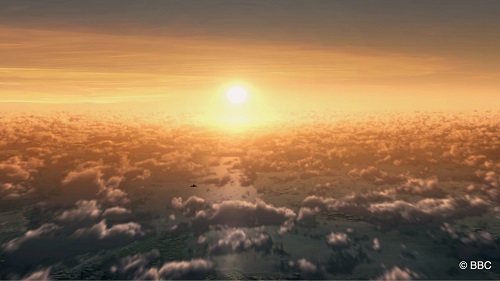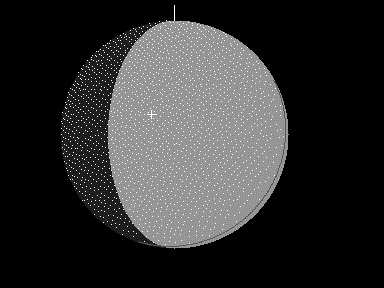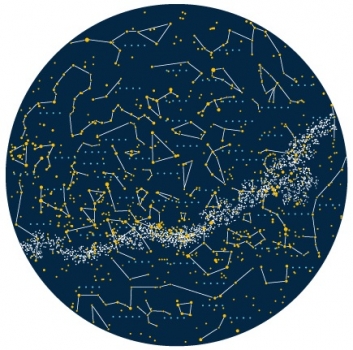(重播)零距離科學3:大自然的力量 – 停不了的地球

大自然的力量,令地球自數十億年前誕生之後便一直轉動至今。它在太空運行的漫長旅程,令各種生命得以從中成形。地球以高速自轉,同時圍繞太陽運行,然而我們身處地球表面卻毫無感覺。在本節目中,我們將會跟隨全球其中一架最先進的飛機──颱風式戰鬥機,參與一個精心策劃的飛行任務,他們的目標是要超越地球自轉的速度。
月球一直環繞住地球運行,與地球一同經歷漫長的太空旅程。有時,地球、月球及太陽會連成一條完美的直線。這個現象每年都會出現幾次。當這幾個天體的引力同時影響亞馬遜河口,就會帶來地球上其中一個最強大的激潮──「波羅羅卡」(Pororoca)。當地人看到波羅羅卡來臨都會躲到屋裡,有人卻反其道而行。滑浪手塞雷尼奧‧勞斯曾經乘著波羅羅卡的浪,連續滑浪超過六英里距離,創下世界紀錄。
科學家相信,在45億年,剛剛形成的地球曾經和一個有如火星般大小的天體相撞。殘留的石頭碎片飛到太空中。這些石頭慢慢積聚,就形成了月球,而地球則因此側斜了23.5度。這個傾斜度,令我們有一年四季。地球某部分地區更會感受到極端的季節轉變。
當地球沿著其傾斜的軸心自轉和圍繞著太陽公轉時,我們亦在不知不覺之間,成為了漫長太空旅程的過客。人類以不同的儀式讓自己在時間的洪流中留下足硛,每年在意大利薩丁島舉行的賽馬活動阿德利亞,便是其中一例。
時間:
●2017.05.06(六) 00:30 ~ 01:30 (重播)
●2017.05.08(一) 12:00 ~ 13:00 (重播)
頻道:港台電視31 及 港台電視31A
#125
此活動由香港電台TV主辦。
小太空人訓練計劃 – 全能小太空人訓練營

小太空人訓練計劃 全能小太空人訓練營
50位晉身第二輪複選的申請者,各與一名同行家長參加此訓練營,藉此提升小朋友的自信心、探索精神,以及太空知識
日期:2017.05.06(六) – 2017.05.07(日)
名額:50 親子對
此活動由美國萬通主辦。
點亮星辰:動漫裡的天文學 第二季

時間:2017.05.06(六) 17:00 ~ 18:15
地點:澳門科學館天文館
講者:吳年繼 (澳門科學館天文館)
語言:普通話
免費活動,惟參加者必須於當日講座前先到售票處領取門票
#95
此活動由澳門科學館主辦。
手機月球攝影‧寶瓶座流星雨 觀星營

入黑後,各春季星座如代表大熊座、英偉的牧夫座、手持麥穗星的室女座、威武的獅子座、小小的烏鴉座等已經出現,而木星及月球亦早在晚上九時升上天頂。晚上十時後,土星亦漸漸從東方的地平線升上。透過天文望遠鏡,我們可以看到月球表面的月海、環形山及隕石坑、木星的南北赤道帶及衞星以及土星及其壯麗的土星環。
到了凌晨三時,月球會在西邊落下,而我們觀星營當晚的另一重點 – 寶瓶座ETA流星雨,亦到了最佳觀測時間。是根據國際流星組織的預測,寶瓶座ETA流星雨高峰期正值觀星營當晚,每小時流星數目最多可達30顆,實在不容錯過。 觀星營內,由多名資深天文導師深入指導各位營友觀賞星空,更提供多座天文望遠鏡供參加者使用,欣賞夜空中多個形態不同的的有趣星體。
日期:2017.05.06(六) ~ 2017.05.07(日)
地點:香港青年協會賽馬會西貢戶外訓練營
集合:2017.05.06(六) 15:00 @西貢市中心巴士總站(認會旗)
離營:2017.05.07(日) 11:00
收費活動,參加者必須報名,名額有限,先到先得
#64
此活動由坐井會主辦。
寶瓶座η流星雨極大

相關流星群:寶瓶座η流星雨 (ETA)
出現日期:
4月19日至5月28日
極大日期(香港時間):
5月6日(星期六)9時31分
月閃高峰期:
遲1.6小時
天頂每時出現率ZHR:60顆
速度:每秒66公里(中速)
亮度指標:2.4(中等)
輻射點(曆元2000):
赤經22.5時/338°赤緯-1°
有關今次天象更詳細資料請按左下角「外部連結」
2016-17年度天文課程 (中學天文課程)

中學天文課程
日期:
2017.05:05(五),12(五),16(二),22(一),26(五)
2017.06:02(五),09(五),16(五),20(二)
時段:14:00 ~ 16:30
日期:2016.10.25(二) ~ 2017.06.27(二) (指定日期晚間可選)
2016.10.25(二)
2016.10:26(三),28(五)
2016.11:14(一),21(一),22(二),28(一),29(二)
2016.12:06(二),20(二),21(三)
2017.01:05(四),06(五),09(一),10(二),16(一),24(二)
2017.02:07(二),22(三),24(五)
2017.03:03(五),08(三),13(一),14(二),20(一),21(二),28(二)
2017.04:05(三),07(五),10(一),11(二),25(二)
2017.05:12(五),16(二),22(一),23(二),25(四),31(三)
2017.06:01(四),02(五),05(一),08(四),12(一),15(四),19(一),27(二)
時段:19:00 ~ 21:30
地點:荃灣荃錦公路101號 嗇色園可觀自然教育中心暨天文館
◎高中天文課程
對象: 中四至中六級物理科學生
◎日間/晚間天文活動
對象:中一至中六學生
名額:每節45
免費課程,惟不包括交通費,2016.10.03(一) 09:00起,參加者必須報名,2016.10.13(四) 13:00截止,抽籤選拔
【訊息由張詠倫提供】
此活動由可觀自然教育中心暨天文館主辦。
零距離科學3:大自然的力量 – 停不了的地球

大自然的力量,令地球自數十億年前誕生之後便一直轉動至今。它在太空運行的漫長旅程,令各種生命得以從中成形。地球以高速自轉,同時圍繞太陽運行,然而我們身處地球表面卻毫無感覺。在本節目中,我們將會跟隨全球其中一架最先進的飛機──颱風式戰鬥機,參與一個精心策劃的飛行任務,他們的目標是要超越地球自轉的速度。
月球一直環繞住地球運行,與地球一同經歷漫長的太空旅程。有時,地球、月球及太陽會連成一條完美的直線。這個現象每年都會出現幾次。當這幾個天體的引力同時影響亞馬遜河口,就會帶來地球上其中一個最強大的激潮──「波羅羅卡」(Pororoca)。當地人看到波羅羅卡來臨都會躲到屋裡,有人卻反其道而行。滑浪手塞雷尼奧‧勞斯曾經乘著波羅羅卡的浪,連續滑浪超過六英里距離,創下世界紀錄。
科學家相信,在45億年,剛剛形成的地球曾經和一個有如火星般大小的天體相撞。殘留的石頭碎片飛到太空中。這些石頭慢慢積聚,就形成了月球,而地球則因此側斜了23.5度。這個傾斜度,令我們有一年四季。地球某部分地區更會感受到極端的季節轉變。
當地球沿著其傾斜的軸心自轉和圍繞著太陽公轉時,我們亦在不知不覺之間,成為了漫長太空旅程的過客。人類以不同的儀式讓自己在時間的洪流中留下足硛,每年在意大利薩丁島舉行的賽馬活動阿德利亞,便是其中一例。
時間:
●2017.05.05(五) 21:00 ~ 22:00
●2017.05.06(六) 00:30 ~ 01:30 (重播)
●2017.05.08(一) 12:00 ~ 13:00 (重播)
頻道:港台電視31 及 港台電視31A
#125
此活動由香港電台TV主辦。
立夏

15時31分立夏,太陽黄經45度。
夏天開始,雨水增多,農作物生長漸旺,田間工作日益繁忙。
軒轅十四合月

18時14分,軒轅十四在月球北面0.52度
星系團MACSJ0329-0211中央巨大橢圓星系的近期恆星形成史

Public Seminar of RPg Student:- Recent Star Formation History of the Central Giant Elliptical Galaxy of the Cluster MACSJ0329-0211
A number of cluster central giant elliptical galaxies(a.k.a. brightest cluster galaxies, BCGs) exhibit recent or ongoing star formation that is most clearly revealed in the UV continuum. The nature of this star formation activity (i.e., origin of the star-forming gas, star formation rate over time) is poorly understood. The best data currently available for elucidating the star formation history of BCGs come from the Cluster Lensing And Supernova survey with Hubble(CLASH), which spans wavelengths from the near-UV to the near-IR in 16 filters. Previous studies using this data have used only the UV filters to estimate star formation rates(SFR) in this BCG assuming a certain star formation history(i.e., nearly constant SFR over 100 Myr). Here, we derive the spatially-resolved spectral energy distribution (SED) of the relatively young stellar population so as to infer its star-formation history through population synthesis modeling. We anticipate our work to set a benchmark for what can be learnt from this unique and high quality data set having unprecedented wavelength coverage.
To obtain the SED of the young stellar population, we first have to subtract the light contributed by the old stellar population in every filter band. To model the 2-dimensional light distribution of the old stellar population, we used images in the longest-wavelength bands where the old stellar population dominates the overall light. In doing so, we found it necessary to mask out nearby cluster members, as well as both the young stellar population and dust based on color images of the BCG. The model parameters for the 2-D light distribution of the old stellar population thus derived was consistent among the reddest filter bands, allowing us to construct a wavelength-averaged model applicable to all filter bands. The images obtained after subtracting the model for the old stellar population have good consistency with the spatial distribution of the young stellar population that dominates the UV images, as well as color images of the BCG.
To make a preliminary look and to obtain global view of the data, we compared a color-color diagram (constructed from three line-free filters) of the young stellar population with population synthesis model. The results, which are only weakly sensitive to metallicity, implies ages ranging from ~10 Myr to nearly 1Gyr for the young stellar population.
We are now in the process of modeling the entire SED to determine: (i) whether the ages thus inferred are compatible with that those inferred from the color-color diagram; (ii) the degree to which we can break the age-metallicity degeneracy; (iii) whether it is necessary to include dust extinction, and the extra degree of degeneracy in doing so.
時間:2017.05.04(四) 10:00
地點:香港大學 莊月明物理樓105室
講者:Junhao LI (香港大學)
語言:英語
免費會議,歡迎參加
#119
此活動由香港大學物理系主辦。

